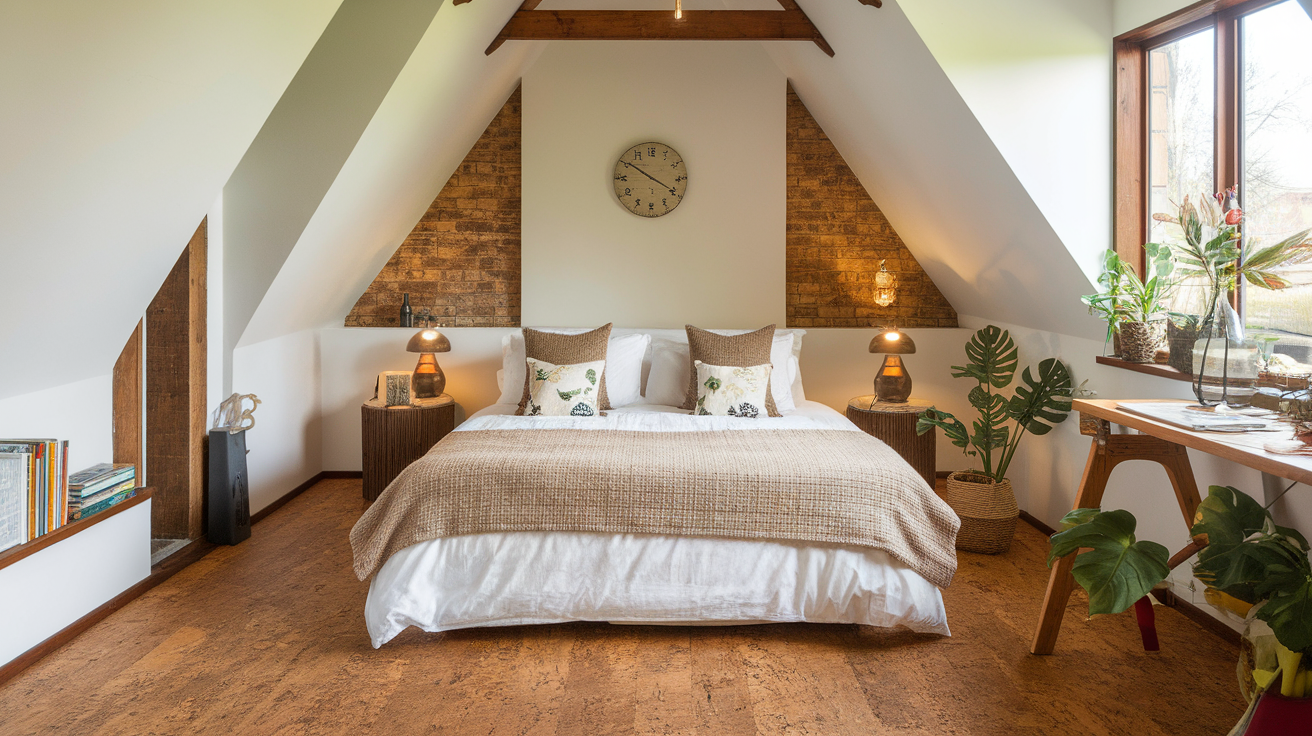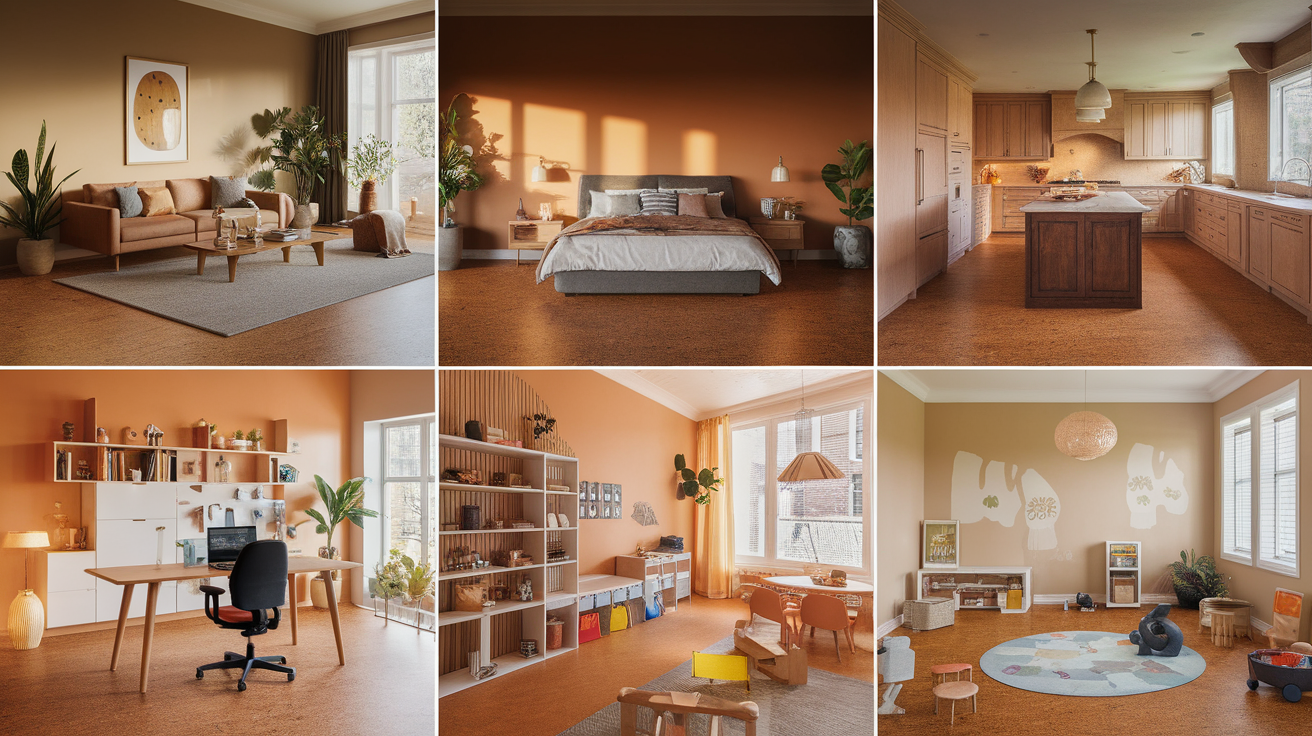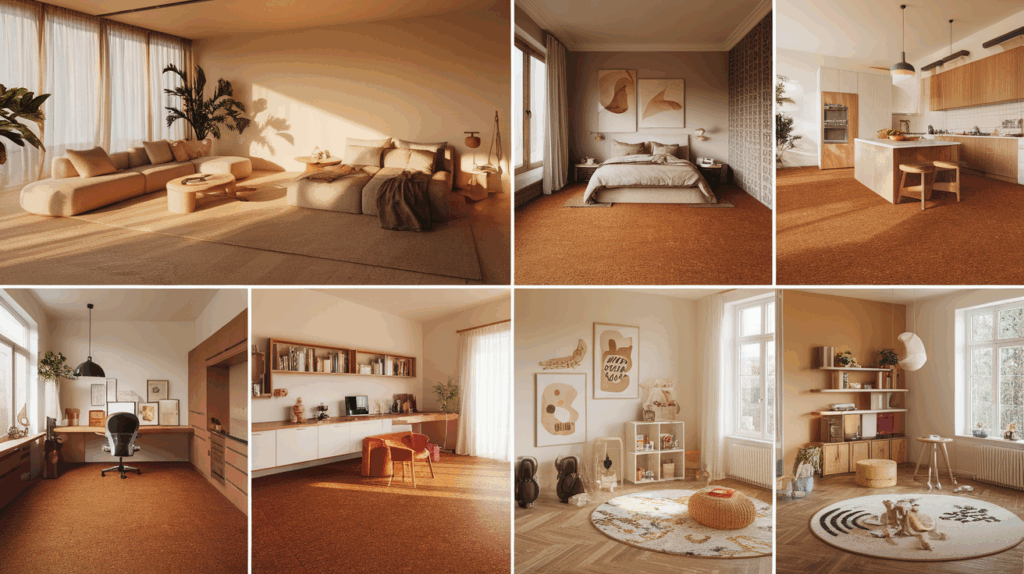If you’re like me and want a floor that’s both comfy and eco-friendly, cork flooring might be just what you need.
It’s soft, warm, and feels amazing under your feet. Plus, it’s made from the bark of a tree, so it’s a natural choice that’s good for the planet.
What I really like about cork is how it keeps my home quiet and cozy. It’s also super easy to clean, which is a big win in busy spaces like the kitchen or hallway.
Cork works well in all kinds of rooms, from bedrooms to living areas, and it comes in a variety of styles and colors.
Whether you love a modern look or prefer something more classic, there’s a cork floor that’ll fit right in.
In this blog, I’ll walk you through all the great benefits of cork flooring. You’ll see why it’s a smart pick for comfort, health, and even saving on energy bills.
What Is Cork Flooring?
Cork flooring is a type of floor made from the bark of the cork oak tree. This special tree grows mostly in places like Spain and Portugal.
The cool thing is that the bark can be gently removed without hurting the tree. After a few years, the bark grows back, so it’s a natural and renewable resource.
To make cork flooring, the bark is ground up, pressed into sheets, and then turned into tiles or planks. These pieces can be glued down or clicked together like puzzle pieces.
The surface is often sealed to protect it from wear and water.
Cork flooring feels soft and warm when you walk on it. It also helps keep rooms quiet because it absorbs sound.
It’s a great choice if you want something natural, comfy, and good for the environment.
Types of Cork Flooring

There are a few different types of cork flooring to choose from. Each one has its own style, feel, and way of being installed.
Whether you’re doing a big room makeover or just updating a small space, it’s good to know your options.
| Type | Description | Best For |
|---|---|---|
| Glue-Down Tiles | Tiles that are glued directly to the subfloor. | Small rooms or areas needing quiet |
| Floating Planks | Planks that click together and “float” above the subfloor without glue. | DIY projects and large rooms |
| Sheet Cork | Large sheets of cork are often used in commercial or custom spaces. | Unique designs or large areas |
| Cork-Backed Laminate | A laminate top with a cork bottom layer for extra comfort and quiet. | Homes that want the look of wood |
Each type has its perks, so it really comes down to your needs, budget, and how handy you are with tools.
No matter which one you choose, cork flooring brings comfort, quiet, and style to your space.
Top Benefits of Cork Flooring

Cork flooring has become a favorite for many homeowners, and it’s easy to see why.
It offers a bunch of great benefits that make it stand out from other flooring types. From being soft under your feet to helping the planet, cork has a lot to love.
1. Soft and Comfortable to Walk On
One of the best things about cork flooring is how soft it feels. Unlike hard floors like tile or hardwood, cork has a little bounce to it.
This comes from its tiny air pockets, which make it feel cushioned. Walking or standing on cork feels easier on your feet, knees, and back.
It’s especially nice in kitchens where you’re standing a lot, or in kids’ rooms where they play on the floor.
2. Natural Warmth
Cork flooring naturally stays warmer than tile or vinyl. Those same air pockets that make it soft also help trap heat.
That means when you step on it barefoot, it doesn’t feel cold, even in the winter.
This can help make your rooms feel cozier and more comfortable without needing to crank up the heat.
3. Quiet and Sound-Absorbing
If you want a quieter home, cork flooring is a great choice. It absorbs sound really well. That means less noise from footsteps, dropped toys, or moving furniture.
It’s especially helpful in apartments, upstairs bedrooms, or homes with kids and pets. Some people even use cork in music rooms or offices to cut down on echoes.
4. Eco-Friendly and Renewable
Cork is one of the most earth-friendly flooring choices you can make. It comes from the bark of the cork oak tree, which grows back after being harvested.
That means no trees are cut down to make cork flooring. Plus, cork is biodegradable, so it won’t sit in a landfill forever when it’s old.
Choosing cork helps reduce waste and protect forests, making it a smart choice for the planet.
5. Hypoallergenic and Healthy
If you have allergies, cork flooring can help. It doesn’t hold onto dust, pet hair, or pollen the way carpets do.
And cork contains a natural substance called suberin that helps keep out mold, mildew, and insects.
This makes it a good option for people with asthma or allergies, or anyone who wants a cleaner, healthier home.
6. Durable and Long-Lasting
Don’t let the soft feel fool you, cork is also tough. It bounces back from dents, and it doesn’t scratch easily.
With the right care, cork floors can last 20 to 30 years or more. Most cork floors come with a protective finish that helps keep them strong and looking great.
If they start to look worn, they can even be refinished to bring back their shine.
7. Easy to Maintain
Caring for cork flooring is pretty simple. Regular sweeping or vacuuming keeps it clean, and a damp mop works well for spills or dirt.
You don’t need special cleaners; avoid harsh chemicals. Every few years, you can re-seal your cork floor to help it stay strong and water-resistant.
With just a little care, cork flooring stays beautiful for years.
8. Great for Many Rooms
Cork works well in lots of different spaces. It’s perfect for bedrooms, living rooms, kitchens, offices, and playrooms.
Some people even use it in finished basements. However, cork doesn’t like too much water, so it may not be the best choice for bathrooms or laundry rooms unless it’s properly sealed.
9. Stylish and Versatile
Cork flooring isn’t just practical, it’s also good-looking. You can find it in a bunch of colors, patterns, and finishes.
Some styles look like wood, while others have a more modern or natural look. Whether your style is rustic, modern, or somewhere in between, there’s a cork floor that will fit your home.
10. Energy Efficient
Cork’s natural insulation helps keep rooms warmer in the winter and cooler in the summer.
That means your heating and cooling systems don’t have to work as hard. Over time, this can help you save money on your energy bills while keeping your home comfy all year round.
Cork flooring is soft, quiet, warm, healthy, and kind to the planet. It’s a smart choice for anyone who wants a comfortable home without giving up style or strength.
Whether you’re updating a single room or your whole house, cork is definitely worth a closer look.
Where to Use Cork Flooring?

Cork flooring isn’t just comfy and eco-friendly; it’s also super flexible in terms of where you can use it.
I’ve found it works great in lots of different spaces around the house. But from my experience, there are a few things to keep in mind before deciding where to put it.
Some areas are perfect for cork, while others might need a little extra care or protection to make sure it holds up well over time.
1. Living Room: Cork is soft underfoot, which makes it perfect for places where you relax and hang out. It adds warmth and helps reduce noise, which is great for cozy movie nights or family time.
2. Bedroom: Want a floor that feels warm and soft when you get out of bed? Cork is a great choice. It’s quiet, comfy, and helps make your bedroom feel calm and peaceful.
3. Kitchen: Cork is a smart pick for kitchens because it’s gentle on your feet while you cook or clean. Just make sure it’s properly sealed to protect it from spills and water splashes.
4. Home Office: Cork keeps noise down, which is helpful if you’re taking calls or focusing on work. It also adds comfort for long hours at your desk.
5. Playroom or Kids’ Room: The soft and bouncy feel of cork makes it a safe choice for kids’ spaces. It’s gentle if someone takes a tumble, and also helps reduce loud sounds from playing.
6. Basement (If Finished and Dry): Cork can work in finished basements that stay dry. It helps warm up the space and makes it feel less like a basement. Just make sure there’s no moisture problem before installing.
7. Hallways and Entryways: Cork is durable enough for light to medium traffic areas like hallways. It helps quiet footsteps and gives a warm welcome when you walk through the door.
I’ve found that cork flooring works really well in most parts of the home, as long as the area stays mostly dry.
I usually avoid putting it in places with a lot of water, like bathrooms or laundry rooms, unless I plan to use a special waterproof sealant.
With the right care and a little planning, cork has been a stylish and smart choice in so many of my spaces!
Factors to Consider Before Choosing Cork Flooring
Cork flooring offers many benefits, but like any flooring choice, it’s important to consider it carefully before making a decision.
- Moisture Levels: Cork doesn’t do well with a lot of water. If you’re thinking about using it in bathrooms or basements, you’ll need to seal it properly and check for moisture often.
- Sunlight Exposure: Cork can fade if it gets too much direct sunlight. If your room has lots of windows, you might want to use rugs or curtains to protect the flooring.
- Furniture Weight: Heavy furniture can leave marks or dents in cork. Use furniture pads under legs and avoid dragging pieces across the floor.
- Maintenance Needs: Cork is easy to clean, but it does need a little extra care. You’ll need to reseal it every few years to keep it strong and water-resistant.
- Cost and Budget: While cork is cheaper than hardwood, it can be more expensive than vinyl or laminate. Make sure it fits your budget for both materials and installation.
- Style and Color Choices: Cork comes in many designs, but it may not match every look. Take time to look into the color and pattern options to find one that suits your style.
Considering these factors can help you decide if cork flooring is the best match for your space.
With the right setup and care, cork can be a smart, long-lasting choice that you’ll enjoy for years to come.
Conclusion
Cork flooring is a smart and comfortable choice for many homes. It’s soft underfoot, quiet, and helps keep rooms warm.
Plus, it’s good for the environment and safe for people with allergies. Whether you want a cozy bedroom floor or a quiet space for your home office, cork can work well in many areas.
It also comes in many styles and colors, making it easy to match your home’s look.
Before choosing cork, consider moisture, sunlight, and furniture weight. With a little care and the right setup, cork flooring can last for many years.
Cork is a great option if you want something beautiful and eco-friendly. If you’re looking for a comfy, natural floor, it might be the perfect fit for your home.

